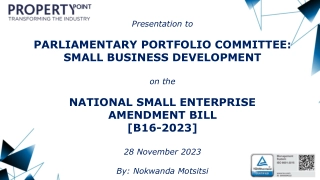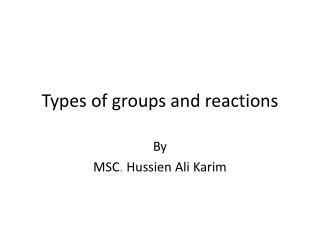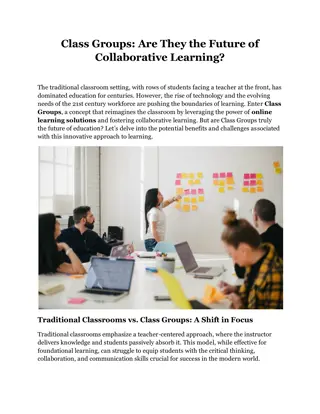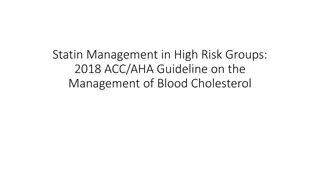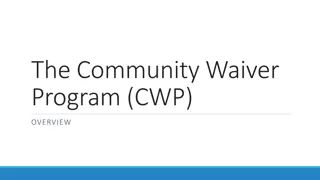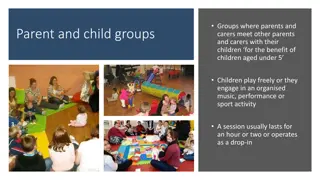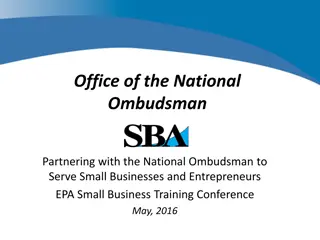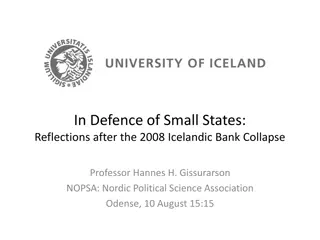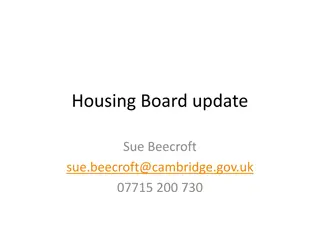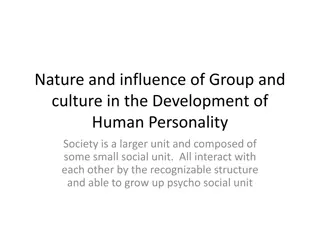
Small Group Dynamics in Communication
Explore the dynamics of small groups, identifying characteristics, types, roles, challenges, and benefits within these groups. Understand how shared identity, goals, and interdependence shape interactions, and reflect on your own group memberships. Discover effective strategies for collaboration in small group communication.
Uploaded on | 2 Views
Download Presentation

Please find below an Image/Link to download the presentation.
The content on the website is provided AS IS for your information and personal use only. It may not be sold, licensed, or shared on other websites without obtaining consent from the author. If you encounter any issues during the download, it is possible that the publisher has removed the file from their server.
You are allowed to download the files provided on this website for personal or commercial use, subject to the condition that they are used lawfully. All files are the property of their respective owners.
The content on the website is provided AS IS for your information and personal use only. It may not be sold, licensed, or shared on other websites without obtaining consent from the author.
E N D
Presentation Transcript
Public Speaking Module 14: Small Group Communication
Module Learning Outcomes Recognize typical dynamics of small groups and identify effective strategies for effective collaboration 14.1: Identify typical dynamics of small groups 14.2: Identify strategies for meeting productively as possible 14.3: Explain the characteristics of communication within and as a group
Learning Outcomes: Small Group Dynamics 14.1: Identify typical dynamics of small groups 14.1.1: Identify different characteristics of small groups 14.1.2: Identify different types of groups 14.1.3: Identify different roles in small groups 14.1.4: Describe some challenges of working in small groups 14.1.5: Describe some benefits of working in small groups
Types of Groups Primary Groups Relationship based Family, friends, roommates Longer Term Secondary Groups Task based Activity Groups Bowling league Personal Growth Groups Alcoholics Anonymous Learning Groups Study Groups Problem-Solving Groups Committees
Small Group Characteristics Not all groups are small group. Small groups share three main characteristics Shared Identity Shared Identity Shared Goals Shared Goals Interdependence Interdependence Members share a sense of belonging Goals may be obvious and precise or loosely defined Dependence on one another to meet the group goal Not every member may agree on a goal or how to meet it Each member s behavior influences the others
Class Activity: What small groups do you belong to? Jot down as many of the small groups that you belong to as you can. Include both primary and secondary groups. (2 minutes) Reflect on: The shared goals of each of your secondary small groups How your small groups communicate a shared identity Situations in which you became aware of the group s interdependence
Roles in Small Groups TASK SOCIAL ANTI-GROUP Performs behaviors to move the assignment forward Performs social maintenance and harmony of the group Individual, self-serving roles that work against the group Blocker Avoider Recognition Seeker Distractor Troll Information Giver Information Seeker Elaborator Administrator Harmonizer Gatekeeper Sensor
Taxonomies of Roles Organizer: Structures the team and task to ensure goals are being met Doer: Completes taskwork Challenger: Challenges the team to question assumptions and approaches to the task Innovator: Generates ideas and solutions Team Builder: Maintains a positive atmosphere within the team, establishes norms, and supports team decisions Connector: Connects the team with outside entities
Challenges and Benefits of Small Group Dynamics CHALLENGES BENEFITS Interpersonal Challenges Cultural and Gendered differences Power Struggles Lack of Resources and Support Naysayers and other Antisocial Roles Inadequate or Ineffective Leadership Groupthink Social loafing Shared Decision-Making Shared Resources Synergy Exposure to New Ideas
Practice Question 1 In a small group, each group member s behavior influences the others. What characteristic of a small group does this phenomenon represent? A. Shared Identity B. Shared Goals C. Interdependence D. Group Challenges
Practice Question 2 In her small group meeting, Marcy notices that Andrew hasn t said much. She asks him to share his thoughts about the research another group member just shared. What role did Marcy take on? A. Information seeker B. Gatekeeper C. Information giver D. Recognition seeker
Class Activity The Challenger Explosion is a well-known result of Group Think. Watch the video below and identify other factors that led to Group Think https://www.youtube.com/watch?v=OomSth3zGBs Identify present or missing roles Other challenges of group dynamics Discuss which group roles or actions could have prevented Groupthink from occurring
Learning Outcomes: Small Group Meetings 14.2: Identify strategies for meeting productively as a group 14.2.1: Describe strategies for planning effective small group meetings 14.2.2: Describe strategies for managing small group meetings 14.2.3: Explain the qualities of a leader in a small group setting
Planning Group Meetings Careful Planning Clarify the purpose and goal Clarify how and when the meeting will take place Clarify Roles Tasks that will be performed during and before the meeting Create and Distribute the Agenda
Managing Small Group Meetings Come Prepared Each member knows: what they are expected to bring to the meeting what will be discussed and performed during the meeting Stay Focused Watching and managing time Flexible but goal-oriented Pause and Summarize Create clarification opportunities Manage Conflict Consensus, democratic, authoritarian Follow-Up Distribute notes, assignments, and deadlines
Leadership in Small Groups Leadership can be: Implied Designated Emergent Deference to Expertise Assigned or Selected Default through organization or leadership traits Effective Leadership Qualities: Flexibility Accountability Intrinsic Power Vision Credibility Addresses Procedural, Task, and Maintenance Needs
Practice Question 3 During Simone s meeting, two members disagreed about what type of visual aid should be used in the final presentation. Simone admitted that it was an important discussion, but that the group should address what the presentation will be about first. What part of managing a small group meeting did Simone exhibit? A. Pause and Summarize B. Come Prepared C. Manage Conflicts D. Stay Focused
Practice Question 4 Eric s book club is social and casual. Because of this, no one wanted to make decisions about how monthly themes would be decided or who would lead each month s discussion. He decided to collect everyone s emails, put together a shared document with suggestions for themes and discussion leaders and distributed it. During the next meeting, he took the opportunity to ask when and where next month s meeting should take place. Eventually, Eric began facilitating the book club. What type of leadership does Eric have in the book club? A. Implied B. Designated C. Emergent D. Situational
Learning Outcomes: Group Development and Communication 14.3: Explain the characteristics of communication within and as a group 14.3.1: Identify the five development stages of groups 14.3.2: Identify the steps of the Reflective-Thinking Method for decision making in small groups 14.3.3: Identify strategies to effectively participate in small group discussions and decision-making 14.3.4: Describe different formats for presenting as or for a small group
The Five Development Stages of Groups Forming Polite phase Creating shared expectations, guidelines, charters Storming Group conflict and dysfunction Boundaries and expectations are challenged Learn each other s strengths and weaknesses Norming Roles are understood Conflicts are resolved Performing Projects go smoothly and efficiently Synergy is achieved Adjourning Group disbands
The Reflective-Thinking Method for Decision Making 1. Define the Problem Use clear, specific, unbiased language Phrase as a question what is to be solved for? 2. Analyze the Problem Identify the scope Perform thorough research Ask what information is missing 3. Establish criteria for solutions Standards to evaluate solutions: Musts and Wants 4. Generate possible solutions Brainstorm both individually and as a group 5. Select the best solution Establish ranking system using the merits of each criteria
Class Activity: What will you bring? Break into groups of 5 Scenario: Your group is going on a wilderness hike for 3 days with no access to wifi, electricity, shelter, or running water. Each person in your group can only bring 2 items in addition to a backpack. Your group has 20 minutes to decide on 10 items to bring that they will need to survive together and rank them in order of importance. The goal is to have everyone agree on the 10 items as well as their ranking in 30 minutes.
Small Group Discussions Commit to the Group s Goals Align personal goals with the group s goals Complete Your Tasks Follow through on assigned tasks Pay attention during discussions Avoid Interpersonal Conflict Ad hominem attacks and disrespect are bad Constructive conflict over ideas and decisions is good Encourage Full Participation Supportive communication and positive feedback Seek out all perspectives and opinions Keep on Track Flexible but focused on goals and tasks
Presenting as a Group Individual Report A designated group member presents group findings or recommendations Symposium Each member presents a different aspect of the same topic Panel Discussion Some or all members present Informal and conversational Adhering to time limits is important for each group member Q&A may be addressed with the entire group Moderator is used to introduce, ask questions, and facilitate discussion
Practice Question 5 Boundaries, expectations, and guidelines are established during which stage of group development? A. Forming B. Norming C. Storming D. Performing
Practice Question 6 Charlie s group worked together to put forth a recommendation for a new scholarship their school would award. Each group member was responsible for a different aspect of planning for the scholarship: funding, PR, etc. Charlie presented the scholarship plan at the next Board meeting and all group members were present to answer questions and offer support. What type of group presentation did Charlie s group deliver? A. Individual Report B. Symposium C. Panel Discussion D. None of these
Quick Review Small groups share three characteristics: shared identity, shared goals, and interdependence Group Roles address task, social, or self-serving (destructive) needs Categories include: Organizer, Doer, Challenger, Innovator, Team Builder, Connector Leadership can be implied, designated, or emergent Effective Group Meetings require members to: Come prepared, stay focused, pause and summarize, manage conflicts, and follow-up The Five Development stages of small groups are: Forming, Storming, Norming, Performing, Adjourning The Reflective-Thinking Method is effective for group decision making Define the problem, analyze the problem, establish criteria for solutions, generate possible solutions, select the best solution Members in successful group discussions: commit to the group s goals, complete tasks, avoid interpersonal conflict, encourage full participation, and stay on track Group Presentations can be an individual report, symposium, or a panel discussion

